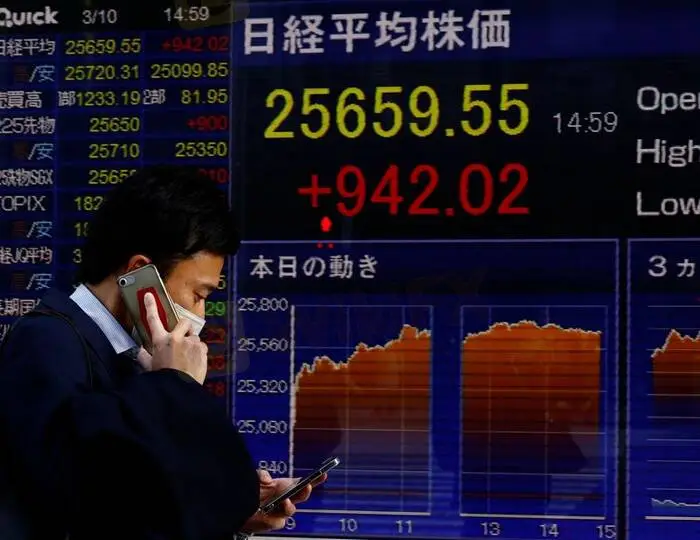简体中文
繁體中文
English
Pусский
日本語
ภาษาไทย
Tiếng Việt
Bahasa Indonesia
Español
हिन्दी
Filippiiniläinen
Français
Deutsch
Português
Türkçe
한국어
العربية
Wall Street dives, dollar jumps as rate hikes take spotlight
Abstract:Asian shares tumbled on Friday as investors fretted about an increasingly aggressive rate-hike outlook for the United States as well as the fallout for the global economy from lockdowns in China.
U.S. stocks tumbled on Friday while the U.S. dollar hit a more than two-year high as investors prepared for a bevy of interest rate hikes in a global inflation fight.
All three major Wall Street indices ended down more than 2% a day after Federal Reserve Chairman Jerome Powell indicated that the U.S. central bank was preparing a half-point interest rate hike at its May meeting, with more to come.

The Dow Jones Industrial Average closed down 2.82%, while the S&P 500 lost 2.77% and the Nasdaq Composite dropped 2.55%.
The MSCI world equity index, which tracks shares in 45 nations, fell 2.46%.
Powell drove headlines on Thursday by saying a 50 basis point rate hike is “on the table” at the Feds next meeting, adding that it “is appropriate to be moving a little more quickly” to combat inflation.
“Markets are very uneasy about the growing likelihood of a policy error by the Federal Reserve. When a Fed official suggests a 50 basis points hike, markets immediately start trying to price in 75 basis point hikes,” said Jamie Cox, managing partner at Harris Financial Group in Richmond, Virginia.
The prospect of aggressive hikes was a boon to the U.S. dollar, which surged to a more than two-year high on Friday. The dollar index, which tracks the greenback versus a basket of six currencies, was last up 0.6% to 101.18, clearing levels not seen since March 2020.
The dollars surge took a toll on fellow safe-haven gold, with spot gold prices falling 0.9% to $1,933.94 an ounce.
Yields on U.S. Treasury bonds were also on the uptick as traders prepared for higher rates, with short-dated bonds hitting three-year highs in Friday trading.
Two-year note yields, highly sensitive to interest rate moves, rose to 2.789%, the highest since December 2018, before dipping lower to 2.697% in the afternoon. Benchmark 10-year yields were last at 2.899%, after reaching 2.981% on Wednesday, also the highest since December 2018.
“Were repeating the same message from central bankers, and every time each repetition ratchets short interest rates higher,” said Jim Vogel, an interest rate strategist at FHN Financial in Memphis, Tennessee.
Oil was down on the week, as concerns of looming interest rate hikes, weaker global growth and COVID-19 lockdowns in China hurting demand outweighed a potential European Union ban on Russian oil that would tighten supply. [O/R]
Brent crude fell 2% at $106.16 a barrel, while U.S. West Texas Intermediate (WTI) crude declined 2.03% to $101.69 a barrel.
(Reporting by Pete Schroeder; Additional reporting by Marc Jones in London, Stella Qiu in Shanghai and Tom Westbrook in Singapore; Editing by Chizu Nomiyama, Will Dunham and Mark Potter)
Disclaimer:
The views in this article only represent the author's personal views, and do not constitute investment advice on this platform. This platform does not guarantee the accuracy, completeness and timeliness of the information in the article, and will not be liable for any loss caused by the use of or reliance on the information in the article.
WikiFX Broker
Latest News
Geopolitical Events: What They Are & Their Impact?
Volkswagen agrees deal to avoid Germany plant closures
Top 10 Trading Indicators Every Forex Trader Should Know
TradingView Launches Liquidity Analysis Tool DEX Screener
MultiBank Group Wins Big at Traders Fair Hong Kong 2024
WikiEXPO Global Expert Interview: Simone Martin—— Exploring Financial Regulation Change
'Young investors make investment decisions impulsively to keep up with current trends' FCA Reveals
Why Do You Feel Scared During Trade Execution?
CySEC Settles Compliance Case with Fxview Operator Charlgate Ltd
Scope Markets Review: Trustworthy or Risky?
Currency Calculator


